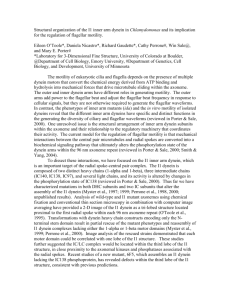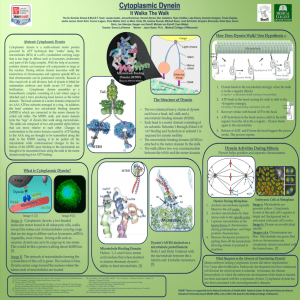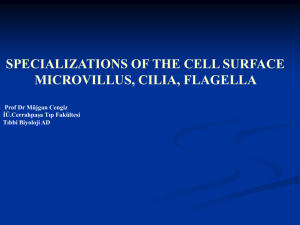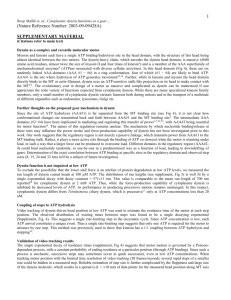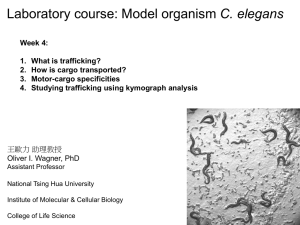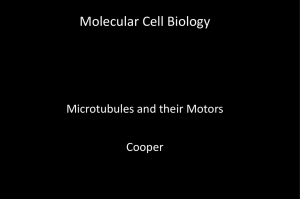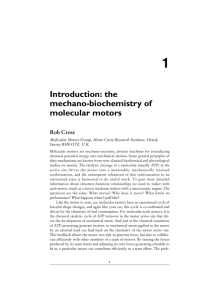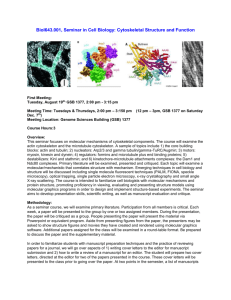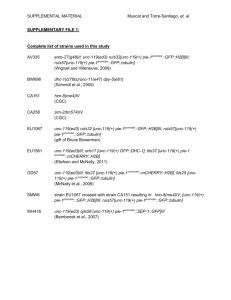Research Summary The cytoplasmic dynein complex, along with its
advertisement
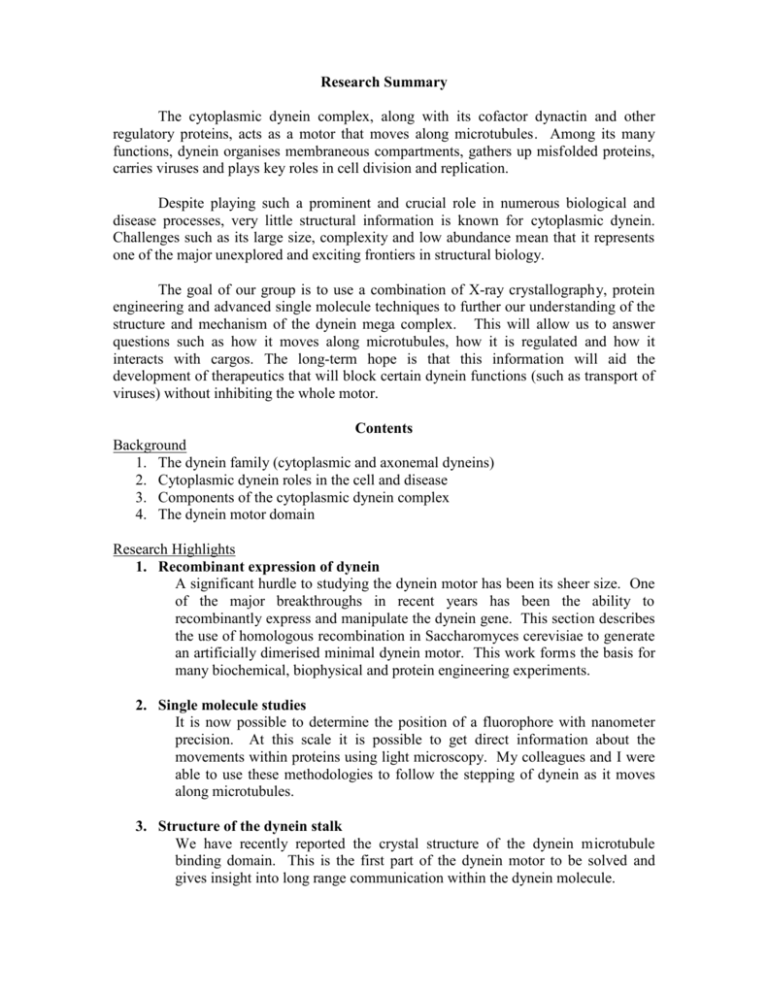
Research Summary The cytoplasmic dynein complex, along with its cofactor dynactin and other regulatory proteins, acts as a motor that moves along microtubules. Among its many functions, dynein organises membraneous compartments, gathers up misfolded proteins, carries viruses and plays key roles in cell division and replication. Despite playing such a prominent and crucial role in numerous biological and disease processes, very little structural information is known for cytoplasmic dynein. Challenges such as its large size, complexity and low abundance mean that it represents one of the major unexplored and exciting frontiers in structural biology. The goal of our group is to use a combination of X-ray crystallography, protein engineering and advanced single molecule techniques to further our understanding of the structure and mechanism of the dynein mega complex. This will allow us to answer questions such as how it moves along microtubules, how it is regulated and how it interacts with cargos. The long-term hope is that this information will aid the development of therapeutics that will block certain dynein functions (such as transport of viruses) without inhibiting the whole motor. Contents Background 1. The dynein family (cytoplasmic and axonemal dyneins) 2. Cytoplasmic dynein roles in the cell and disease 3. Components of the cytoplasmic dynein complex 4. The dynein motor domain Research Highlights 1. Recombinant expression of dynein A significant hurdle to studying the dynein motor has been its sheer size. One of the major breakthroughs in recent years has been the ability to recombinantly express and manipulate the dynein gene. This section describes the use of homologous recombination in Saccharomyces cerevisiae to generate an artificially dimerised minimal dynein motor. This work forms the basis for many biochemical, biophysical and protein engineering experiments. 2. Single molecule studies It is now possible to determine the position of a fluorophore with nanometer precision. At this scale it is possible to get direct information about the movements within proteins using light microscopy. My colleagues and I were able to use these methodologies to follow the stepping of dynein as it moves along microtubules. 3. Structure of the dynein stalk We have recently reported the crystal structure of the dynein microtubule binding domain. This is the first part of the dynein motor to be solved and gives insight into long range communication within the dynein molecule. Background 1) The dynein family and its roles Dyneins are protein complexes consisting of one or more heavy chains and a variety of different light, intermediate and light-intermediate chains. The heavy chain is around 500kDa (4000-5000 amino acids) in size and contains a motor domain that is related to the AAA+ family of proteins. Higher eukaryotes typically contain 10-15 dynein heavy chain genes, which are related by their highly conserved, C-terminal motor domain. In contrast, the N-terminal third of the heavy chains, known as the tail region, is very divergent. Members of the dynein heavy chain gene family include one cytoplasmic dynein gene, which is responsible for most of the transport toward the minus ends of microtubules in the cell (although some is also carried out by minus-end-directed kinesins). There is also typically one intraflagella (IFT) dynein gene that plays a role in the assembly of the bundles of microtubules known as Phylogenetic tree of dynein heavy chain genes. axonemes that make up the core of cilia and flagella. All the remaining dynein genes are known as axonemal dyneins and are responsible for powering the beating motion of axonemes. The axonemal dyneins are themselves divided in outer arm dyneins and inner arm dyneins depending on their location within the axoneme. There is a large variation in number of dynein heavy chain genes found in eukaryotes [1, 2]. Cytoplasmic dynein is an essential gene in many eukaryotes [3], but has been lost from others such as higher plants and some fungi. Axonemal dyneins are missing in a number of species including plants, fungi and the nematode worm C. elegans. In other species, such as the ciliate Tetrahymena thermophila, the number of axonemal innerarm dynein heavy chain genes has undergone a large expansion to 25 copies [4]. 2.1) Roles of cytoplasmic dynein in the cell In interphase cells cytoplasmic dynein is responsible for carrying a diverse range of cargos back towards the nucleus. These include membrane-bound organelles such as components of the endosome pathway [5], golgi vesicles [3] and peroxisomes [6]); as well as transcription factors [7]; aggregated proteins [8]; and mRNA containing particles [9]. In neurons, dynein drives retrograde transport back along axons towards the cell body [10, 11]. Cytoplasmic dynein also plays a fundamental role in mitosis [12-14]. It has been found at the cortex, where it pulls on microtubules attached to the spindle poles [15-17], and at the spindle pole, where it accumulates after transporting factors required for focusing of the poles [18, 19]. It also localises to the kinetochore, where it has a number of possible functions [20], including playing a role in the checkpoint that monitors correct attachment of the spindle to the chromosome [21, 22]. Roles of cytoplasmic dynein in interphase microtubule transport and in mitosis. 2.2) Roles of dynein in disease Given the multiple roles of cytoplasmic dynein in many higher eukaryotes, it is perhaps unsurprising that it should be associated with a number of disease processes. The process of viral infection, for example, involves dynein. Viruses require active transport to the nucleus as they are too big to reach it purely by diffusion. This is especially apparent in the case of herpes viruses, which enter sensory neurons at the nerve termini and then travel back to the cell body in order to set up a latent infection [23]. In addition to viral transport in sensory neurons, dynein has been implicated in many other neuronal diseases. Perhaps the best studied is Lissencephaly. Mutations in the dynein regulatory protein Lis1 result in defects in dynein mediated movement of nuclei within certain neurons. This results in failure of these neurons to migrate during brain development, leading to brains with an unusual smooth appearance as well as severe retardation and early death [24]. Dynein may also have a part to play in a number of neurodegenerative diseases. In mice, mutations in the tail region of dynein lead to phenotypes that resemble patients with motor neuron disease [25]. Furthermore a mutation (G59S) in one of the dynactin subunits, called p150Glued, has been linked to motor neuron disease in both humans and mice. One of the established functions of dynein is to transport aggregated proteins [26], possibly collecting them up so they can be disposed of via phagocytosis. The link between protein misfolding and aggregation in many neurodegenerative diseases, such as Parkinsons and Lewy Body dementias, implies that dynein may have a role to play in these disesase as well. Lewy Bodies themselve resemble aggresomes and may be formed by a dynein dependent process [26]. Finally the role of dynein at the spindle assembly checkpoint means it is involved in a process that is crucial for cancer cell division. This is highlighted by the fact that a number of anticancer compounds, such as vinblastine, are thought to act by blocking this checkpoint for long enough to drive dividing cells into apoptosis. 3) Components of cytoplasmic dynein There are 45 different kinesin motors in humans each with different functions. There is only a single cytoplasmic dynein heavy chain, however, which raises the question of how one protein can carry out so many functions. At least part of the answer may lie with the many accessory factors associated with the core dimer of dynein heavy chains as shown in the figure. Different cargos appear to interact with the cytoplasmic The cytoplasmic dynein complex and some of the cargos that interact with it. dynein complex via different accessory chains. This may be important to allow their attachment to be regulated in order to ensure that only the correct cargo is transported. Specificity may also come from the use of different splice isoforms of the light (LC), light-intermediate (LIC) and intermediate chains (IC). In effect there would be multiple species of dynein within the cell that each carry different cargos and can be individually regulated. For example LIC1 but not LIC2 has been shown to be responsible for transport of pericentrin, a centrosomal component [27]. In contrast only the LIC2 isoform is present in the pool of dynein that mediates fast retrograde transport in axons [28]. The cytoplasmic dynein complex is more than just a set of scaffolding proteins linked to a motor domain. A number of the factors, such as Lis1 and dynactin, have been reported to have a direct effect on dynein’s ATPase activity. It is also likely that the dynein will be regulated both in terms of its activity and in when it interacts with its cargos. Understanding this complex web of interactions will require a much better knowledge of the structures of the whole complex. Currently crystal structures of some of the components, including Lis1 [29] and the light chains [30] are known, but much needs to be done to work out how all the components fit together. 4) Structure of the motor domain Structure of the dynein protein and model of how the elements are arranged in the motor. The core of the motor is a ring of six AAA domains (blue). The linker and C terminal region probably lie on top of the ring. The almost one complete turn of antiparallel coiled coil that makes up the stalk emerges from between AAA4 and AAA5 and has the microtubule binding domain (MTBD) at its tip. The minimal motor domain of dynein contains the C terminal ~3000 amino acids of the heavy chain gene [31 ]. It contains six putative AAA+ domains [32], which form an ~15 nm diameter ring structure. The microtubule binding domain is at the tip of a 15nm long stalk, made of an antiparallel coiled coil that emerges from between AAA4 and AAA5 [33]. The N terminal ~400 amino acids of the motor domain form a structure called the “linker” (or sometimes the “stem”) which stretches across the face of the ring. This linker changes position in the different nucleotide states [34], so that in the absence of nucleotide it exits the ring close to AAA4, whereas in the presence of ATP it appears to move nearer to AAA2 [35, 36]. This rearrangement of the position of the linker domain corresponds to the powerstroke that drives motility [37]. Finally other elements, such as the very C terminus of the motor are also likely to sit on top of the AAA ring. The motor domain of dynein is much larger than that of other motor proteins (kinesin and myosin), is evolutionarily unrelated and clearly moves by a very different mechanism [1]. Some of the interesting mechanistic questions that remain to be answered include: whether one [38] or two [36, 39] AAA+ domains hydrolyze ATP per dynein step; exactly how the AAA+ ring communicates with the distant MT binding domain [40]; how flexible the orientation of the stalk is as cytoplasmic dynein moves and how rearrangements in the AAA+ domains are amplified to produce the swing of the linker domain. Research Highlights 1) Recombinant expression of dynein A large body of structural, biochemical and biophysical experiments on other motor proteins, such as myosin V and kinesin, has led to their mechanism of movement being understood in considerable detail. Underpinning much of this research has been the ability to recombinantly express, tag and manipulate their genes as well as the ability to produce them as dimers that move processively for multiple steps. The large size of the dynein gene has, until recently [39, 41], made recombinant expression of its motor domain particularly challenging. Saccharomyces cerevisae (baker’s yeast) offers two significant advantages for the study of dynein. The first is that dynein is not essential for growth, which allows the genomic copy of the gene to be deleted or modified at will. The second is that homologous recombination can be used to alter only the desired region. This does away with the need for dealing with large plasmids, difficult ligation reactions and the use of rare restriction enzyme sites and makes it relatively simple to The use of homologous recombination to modify the cytoplasmic dynein gene in S. cerevisiae. In the first round a manipulate the gene [39]. A typical URA3 gene is inserted into the dynein gene. In the second step scheme for truncating dynein, this URA3 marker is replaced with the desired modification. adding some tags and a strong promoter is shown in the figure to your right. Using this system we artificially dimerised the dynein motor domain using the constitutive dimer glutathione-S-transferase (GST) [42]. We also added a HaloTag from Promega, which is a genetically encoded tag that can be labelled very specifically with a range of different ligands. This allowed us to tag the protein with stable fluorescent dyes, An engineered dynein construct for motility such as rhodamine, or even quantum dots assays: the dynein motor is dimerised by (inorganic crystals that fluoresce very brightly fusing it to GST. The head is tagged with the under UV light). The movie (please see the genetic HaloTag (Promega) that can be website) shows single molecules of these labelled with different fluorescent dyes such fluorescently labelled GST-dynein constructs moving along axonemes. These constructs have now helped open the door to the study of dynein. 2) High precision tracking of single molecules. The movie in the above section shows single, fluorescently labelled dynein molecules moving along microtubules. It is possible to track the position of these fluorescent spots with a precision of a few nanometers as long as they are bright enough [43, 44]. This means that it is possible to follow the individual steps that a motor protein makes as it walks along a microtubule. The two traces in the figure below show the movement of a kinesin and a dynein molecule tagged with a very bright fluorescent molecule called a quantum dot. The kinesin molecule takes regular 16nm steps, which are defined by the spacing of tubulin molecules [45]. In contrast and not unexpectedly given its size and long stalk, the movement of dynein is much less regular and exhibits a large number of forward and backward movements. Traces of kinesin and dynein tagged with quantum dots stepping along microtubules. Note the traces are oriented for ease of display. Dynein and kinesin in fact move in opposite directions. Cartoon of the dynein construct during movement. By attaching quantum dots to different parts of the molecule, we were able to propose an initial model for how dynein moves [42]. In the future, advances in this high precision tracking, such as the ability to monitor two different colour fluorophores simultaneously [46], will allow us to build up a complete picture of how dynein moves along microtubules. Some questions that need to be answered include what angle the stalks make with respect to the microtubule and whether its orientation changes as dynein moves. 3) Structure of the dynein stalk One of the remarkable features of dynein is that its microtubule binding domain (MTBD) is found at the tip of a long stalk [33] and is thus separated by over 10 nm from the rest of the motor. This is in stark contrast to the kinesin and myosin motors where the polymer binding site is an intrinsic part of the motor domain and raises the question of how the two parts of dynein communicate with each other. Such communication is a key part of how motor proteins couple the cycle of ATP hydrolysis to movement. Nucleotide hydrolysis and conformational changes in the AAA+ ring that drive motility occur only after dynein has bound to microtubules. Reciprocally, the MTBD is released from microtubules when ATP binds to the AAA+ ring [47]. An explanation for the communication mechanism has now begun to emerge from recent biochemical experiments and the determination of the crystal structure of dynein’s MTBD, all carried out in collaboration with Ian Gibbons (UC Berkeley) [40, 48]. In order to produce a stable protein construct for crystallization, the dynein MTBD and the top part of the stalk, which forms an antiparallel coiled coil of two alpha helices (CC1 and CC2), was fused into the coiled coil of a protein called seryl-tRNA synthetase (SRS). The 2.3Å crystal structure we solved A) Fusion of seryl-tRNA synthetase (cyan) and the tip of the confirms the coiled-coil dynein stalk (red). B) Close up of the dynein stalk (helices CC1 nature of the dynein stalk and CC2) and the rest of the microtubule binding domain and shows that it is kinked colored in a rainbow of colors from purple (CC1) to red (CC2). Helices H1, H3 and H6 are proposed to form the surface that by the presence of two interacts with microtubules. The conserved proline residues highly conserved proline are shown in red spacefilling representation. residues. The rest of the MTBD consists of a novel fold of alpha helices that pack against the top of the stalk. The top face (including helices H1, H3, and H6) was identified as the site of interaction with microtubules, based on mutations that interfere with binding. Confirmation was provided by docking the crystal structure into an electron-density map of a dynein stalk bound to microtubules that was obtained by cryoelectron microscopy. A) Cryo electron microscopy (EM) reconstruction of dynein stalk bound to microtubules. B) Close up showing a tubulin protofilament (made up of α and β tubulins) and a dynein microtuble binding domain (MTBD) docked into the EM map (blue mesh). We propose that the mechanism of communication along the stalk involves a sliding movement of helix CC1 with respect to the helix CC2 [40, 48]. This model is based on 3 lines of evidence. 1) Changing the fusion site between the stalk and the SRS base by removing exactly four amino acids from CC1 leads to an almost ten fold increase in the affinity of the MTBD for microtubules. This suggests that conformational changes in the AAA ring could alter the affinity of the MTBD by driving a sliding of CC1 relative to CC2 by the equivalent of four amino acids (see the movie on the website for an animation). 2) In a standard coiled coil, such a sliding motion would be highly entropically unfavourable as it would expose some of the hydrophobic residues in the core of the coiled coil (see the movie on the website). The dynein stalk, however, has a conserved feature which may lower the barrier to such a conformational change. The residues in the core of a standard coiled-coil are arranged as two offset stripes of hydrophobic amino acids running up each of the two helices. In the dynein stalk the residues in CC2 mostly follow this regular pattern (see figure below). By contrast, CC1 has one stripe of hydrophobic residues and one of hydrophilic residues. The consequence of this arrangement is that if CC1 slides relative to CC2 then the only residues to be exposed would be the hydrophilic ones whereas the hydrophobic residues simply move from one side of the coiled-coil core to the other. As no hydrophobic residues are exposed to the solvent, the entropic cost of sliding should be considerably reduced in comparison to a regular coiled coil that has predominantly hydrophobic amino acids in its core. A conserved feature of the stalk may aid sliding of the two helices in the stalk coiled coil. Left panel: spacefilling model of the stalk showing the two helices in stalk (CC1 in blue & CC2 in red) and the microtubule binding domain in white. Right panel: the two helices have been open up to show the amino acids that are packed together to form their core. These residues are arranged in a zig-zag pattern, marked with arrows. In CC2 most of the residues are hydrophobic (green) whereas in CC1, those on the left are hydrophobic, whereas those on the right are hydrophilic (orange). 3) Other features of the stalk structure also hint that helix sliding may provide the communication mechanism. CC2 makes multiple contacts with other helices in the MTBD (See figure below), whereas CC1 only makes a small number of interactions with a single helix (H4). This arrangement is consistent with CC1 being relatively free to move, while CC2 is held in place by multiple interactions. Furthermore CC1 is followed by one of the main helices at the microtubule binding interface (H1). This suggests that microtubule binding would cause a rearrangement in the position of H1, which would be propagated back up to the AAA ring by a sliding of CC1 against the relatively rigid CC2. Reciprocally nucleotide driven conformational changes in the AAA ring would, via the movement of CC1, alter the conformation of H1 and thus change the affinity of dynein for the microtubule. Cartoon showing the sequence of amino acids in the dynein stalk. Blue lines show packing of residues in the coiled-coil core. Residues that contact other parts of the microtubule binding domain are marked with a red dot. In comparison to the extensive contacts made by CC2, the first helix (CC1) makes only a small number of contacts with H4. This is consistent with CC2 being relatively rigid, while CC1 can move in response to changes at the microtubule binding interface. References 1. 2. 3. 4. 5. 6. 7. 8. 9. 10. 11. Vale, R.D., The molecular motor toolbox for intracellular transport. Cell, 2003. 112(4): p. 467-80. Wickstead, B. and K. Gull, Dyneins across eukaryotes: a comparative genomic analysis. Traffic, 2007. 8(12): p. 1708-21. Harada, A., et al., Golgi vesiculation and lysosome dispersion in cells lacking cytoplasmic dynein. J Cell Biol, 1998. 141(1): p. 51-9. Wilkes, D.E., et al., Twenty-five dyneins in Tetrahymena: A re-examination of the multidynein hypothesis. Cell Motil Cytoskeleton, 2008. 65(4): p. 342-51. Steffen, W., et al., The involvement of the intermediate chain of cytoplasmic dynein in binding the motor complex to membranous organelles of Xenopus oocytes. Mol Biol Cell, 1997. 8(10): p. 2077-88. Kural, C., et al., Kinesin and dynein move a peroxisome in vivo: a tug-of-war or coordinated movement? Science, 2005. 308(5727): p. 1469-72. Harrell, J.M., et al., Evidence for glucocorticoid receptor transport on microtubules by dynein. J Biol Chem, 2004. 279(52): p. 54647-54. Johnston, J.A., M.E. Illing, and R.R. Kopito, Cytoplasmic dynein/dynactin mediates the assembly of aggresomes. Cell Motil Cytoskeleton, 2002. 53(1): p. 26-38. Ling, S.C., et al., Transport of Drosophila fragile X mental retardation proteincontaining ribonucleoprotein granules by kinesin-1 and cytoplasmic dynein. Proc Natl Acad Sci U S A, 2004. 101(50): p. 17428-33. Schnapp, B.J. and T.S. Reese, Dynein is the motor for retrograde axonal transport of organelles. Proc Natl Acad Sci U S A, 1989. 86(5): p. 1548-52. Paschal, B.M. and R.B. Vallee, Retrograde transport by the microtubuleassociated protein MAP 1C. Nature, 1987. 330(6144): p. 181-3. 12. 13. 14. 15. 16. 17. 18. 19. 20. 21. 22. 23. 24. 25. 26. 27. 28. 29. 30. Gepner, J., et al., Cytoplasmic dynein function is essential in Drosophila melanogaster. Genetics, 1996. 142(3): p. 865-78. Schmidt, D.J., et al., Functional analysis of cytoplasmic dynein heavy chain in Caenorhabditis elegans with fast-acting temperature-sensitive mutations. Mol Biol Cell, 2005. 16(3): p. 1200-12. Heald, R., et al., Self-organization of microtubules into bipolar spindles around artificial chromosomes in Xenopus egg extracts. Nature, 1996. 382(6590): p. 4205. Busson, S., et al., Dynein and dynactin are localized to astral microtubules and at cortical sites in mitotic epithelial cells. Curr Biol, 1998. 8(9): p. 541-4. McGrail, M. and T.S. Hays, The microtubule motor cytoplasmic dynein is required for spindle orientation during germline cell divisions and oocyte differentiation in Drosophila. Development, 1997. 124(12): p. 2409-19. Sharp, D.J., et al., Functional coordination of three mitotic motors in Drosophila embryos. Mol Biol Cell, 2000. 11(1): p. 241-53. Merdes, A., et al., Formation of spindle poles by dynein/dynactin-dependent transport of NuMA. J Cell Biol, 2000. 149(4): p. 851-62. Quintyne, N.J., et al., Spindle multipolarity is prevented by centrosomal clustering. Science, 2005. 307(5706): p. 127-9. Varma, D., et al., Direct role of dynein motor in stable kinetochore-microtubule attachment, orientation, and alignment. J Cell Biol, 2008. 182(6): p. 1045-54. Howell, B.J., et al., Cytoplasmic dynein/dynactin drives kinetochore protein transport to the spindle poles and has a role in mitotic spindle checkpoint inactivation. J Cell Biol, 2001. 155(7): p. 1159-72. Wojcik, E., et al., Kinetochore dynein: its dynamics and role in the transport of the Rough deal checkpoint protein. Nat Cell Biol, 2001. 3(11): p. 1001-7. Diefenbach, R.J., et al., Transport and egress of herpes simplex virus in neurons. Rev Med Virol, 2008. 18(1): p. 35-51. Wynshaw-Boris, A., Lissencephaly and LIS1: insights into the molecular mechanisms of neuronal migration and development. Clin Genet, 2007. 72(4): p. 296-304. Banks, G.T. and E.M. Fisher, Cytoplasmic dynein could be key to understanding neurodegeneration. Genome Biol, 2008. 9(3): p. 214. Kawaguchi, Y., et al., The deacetylase HDAC6 regulates aggresome formation and cell viability in response to misfolded protein stress. Cell, 2003. 115(6): p. 727-38. Tynan, S.H., et al., Light intermediate chain 1 defines a functional subfraction of cytoplasmic dynein which binds to pericentrin. J Biol Chem, 2000. 275(42): p. 32763-8. Susalka, S.J., W.O. Hancock, and K.K. Pfister, Distinct cytoplasmic dynein complexes are transported by different mechanisms in axons. Biochim Biophys Acta, 2000. 1496(1): p. 76-88. Tarricone, C., et al., Coupling PAF signaling to dynein regulation: structure of LIS1 in complex with PAF-acetylhydrolase. Neuron, 2004. 44(5): p. 809-21. Williams, J.C., et al., Structural and thermodynamic characterization of a cytoplasmic dynein light chain-intermediate chain complex. Proc Natl Acad Sci U S A, 2007. 104(24): p. 10028-33. 31. 32. 33. 34. 35. 36. 37. 38. 39. 40. 41. 42. 43. 44. 45. 46. 47. 48. Koonce, M.P. and M. Samso, Overexpression of cytoplasmic dynein's globular head causes a collapse of the interphase microtubule network in Dictyostelium. Mol Biol Cell, 1996. 7(6): p. 935-48. Mocz, G. and I.R. Gibbons, Model for the motor component of dynein heavy chain based on homology to the AAA family of oligomeric ATPases. Structure (Camb), 2001. 9(2): p. 93-103. Gee, M.A., J.E. Heuser, and R.B. Vallee, An extended microtubule-binding structure within the dynein motor domain. Nature, 1997. 390(6660): p. 636-9. Burgess, S.A., et al., Dynein structure and power stroke. Nature, 2003. 421(6924): p. 715-8. Roberts, A.J., et al., AAA+ Ring and linker swing mechanism in the dynein motor. Cell, 2009. 136(3): p. 485-95. Kon, T., et al., ATP hydrolysis cycle-dependent tail motions in cytoplasmic dynein. Nat Struct Mol Biol, 2005. 12(6): p. 513-9. Shima, T., et al., Two modes of microtubule sliding driven by cytoplasmic dynein. Proc Natl Acad Sci U S A., 2006. 103(47): p. 17736-40. Mallik, R., et al., Cytoplasmic dynein functions as a gear in response to load. Nature, 2004. 427(6975): p. 649-52. Reck-Peterson, S.L. and R.D. Vale, Molecular dissection of the roles of nucleotide binding and hydrolysis in dynein's AAA domains in Saccharomyces cerevisiae. Proc Natl Acad Sci U S A, 2004. 101(6): p. 1491-5. Carter, A.P., et al., Structure and functional role of dynein's microtubule-binding domain. Science, 2008. 322(5908): p. 1691-5. Nishiura, M., et al., A single-headed recombinant fragment of Dictyostelium cytoplasmic dynein can drive the robust sliding of microtubules. J Biol Chem, 2004. 279(22): p. 22799-802. Reck-Peterson, S.L., et al., Single-molecule analysis of dynein processivity and stepping behavior. Cell., 2006. 126(2): p. 335-48. Yildiz, A., et al., Myosin V walks hand-over-hand: single fluorophore imaging with 1.5-nm localization. Science, 2003. 300(5628): p. 2061-5. Thompson, R.E., D.R. Larson, and W.W. Webb, Precise nanometer localization analysis for individual fluorescent probes. Biophys J, 2002. 82(5): p. 2775-83. Yildiz, A., et al., Kinesin walks hand-over-hand. Science, 2004. 303(5658): p. 676-8. Churchman, L.S., et al., Single molecule high-resolution colocalization of Cy3 and Cy5 attached to macromolecules measures intramolecular distances through time. Proc Natl Acad Sci U S A, 2005. 102(5): p. 1419-23. Numata, N., et al., Molecular mechanism of force generation by dynein, a molecular motor belonging to the AAA+ family. Biochem Soc Trans, 2008. 36(Pt 1): p. 131-5. Gibbons, I.R., et al., The affinity of the dynein microtubule-binding domain is modulated by the conformation of its coiled-coil stalk. J Biol Chem, 2005. 280(25): p. 23960-5.
